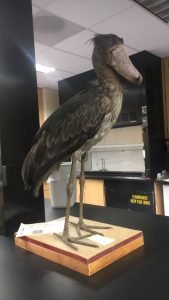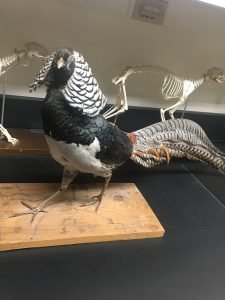We all agree that Cornell is extremely stressing with work load and the difficulty of class. Yet, we will also agree on the fact that Cornell is very diverse and this diversity makes its beauty. Unfortunately when talking about diversity in Cornell, I am not talking about the population even though there are students from various countries. I am mostly talking about the environment. Cornell have so much diverse spaces, various building with different stories, and also the waterfalls. In addition of all, we have the diversity of species found in the Cornell Lab of Ornithology. Even though it is located very far from the campus, this place is worth the trip. They have various type of birds with beautiful plumage. I am not a bird person so I can only comment on how beautiful the plumage is. If when you visit you have the chance on entering one of the room at the back, you should look for the one with dead reptiles. You will see a diverse range of snakes with different size and colors. Don’t worry they are all dead. In addition, they even have skeletons I believe. I did not see as much as I would like to so I will plan to go there again by the end of next year as well as to the museum.
Category Archives: 25/March/2017 – Cornell Lab of Ornithology
Bird, Bird, Bird, Bird is the Word
Before this past weekend, I had no idea bird watching could be so fun and rewarding! Along with GRF, Ty, and a fellow Rose Scholar, I visited Cornell’s renowned Lab of Ornithology. However, to be honest, my favorite part of this event was the bird watching prior to the tour of the lab. I think one of the most valuable lessons gained from the day was to pay attention to your surroundings. I mean, think about. Most of us wake up every morning and walk to class without even knowing what animals, particularly birds, we are surrounded by! Birds are so diverse in sound and personality; they’re definitely more than just a pretty tune in the morning.
So here’s a few things I learned that might help you be a bit more aware of your surroundings. Hopefully this encourages you to stop by the lab or take a walking bird watch tour at some point during your Cornell experience!
As a beginner, you might find it logical to try and memorize different birds by the way they look; however, it would actually be easier to remember the way a bird acts and what they sound like before attempting to remember what different birds look like. The reasons behind this are that birds can be difficult to differentiate. Also, depending on where you are and the weather, you’ll rarely ever get a perfect view of a bird. A lot of the time you won’t even get to see the color on the bird, only shades and shape. Also, if you’re able to identify birds by their sounds, your life becomes a lot easier because once you hear a bird, then you can focus on looking for it (instead of looking for a bird without being able to identify the sound).
What I found most interesting was learning how to identify birds based on their behavior. For example, the American Robin tends to spend its time on ground, with bunny like hops. This is characteristic of many birds in the thrush category. Or take for example, the finch (forgive me I don’t remember exactly what type of finch) tends to hang out in groups high up at the tip of trees. They’re so chatty! They almost sound like they’re gossiping amongst themselves. Chick-a-dees literally make the sound “chick a dee dee dee”. They’re cute little fellows that are always curious and willing to get little closer to see what’s going on, especially when humans walk by. Blue jays are characterized by bully-like behavior and their chirp is a bit harsher than any of the other bird previously mentioned.
I know this sounds like it’s a lot to memorize, but I promise it’s so much fun! Once you see the birds for yourself, you’ll see how unique their personalities can be. It’s also really rewarding once you’re able to remember what a bird sounds/looks like and how it behaves. Now I can show off some of bird identification skills with some of my friends.
Following the walk, we got a tour of the lab. This was my first visit, and I definitely plan on going back to cover the whole lab. The tour offered a more biological and historical perspective of birds and background on the creation of the lab and what it holds. Below I have attached pictures of some pretty fancy birds, however, the lab is not limited to just these figures. I highly recommend stopping by to see the vast amounts of information the lab holds. Bird definitely is the word!
Bird watching: A Great Hobby
I don’t remember when or why I started bird watching. I do know my middle school science fair project was about whether expensive bird seed attracted more birds than the bargain brand, thus justifying the extra expense. Result: Maybe, if you believe a seventh graders science. (I did get to make an awesome stacked bar graph, breaking results down by number and species.) I haven’t been “birding” much recently, and visiting the Cornell lab of ornithology reminded me of why I started birding in the first place. So I’d like to use this blog post as something of a PSA for why everyone should birdwatch.
Firstly, birding is a great way to relieve stress. It gets you out in nature. Also, birds are both cute and charismatic. Our guide at the lab of ornithology talked about the value of anthropomorphizing birds, so that you can recognize and remember them by their personalities, rather than relying on field marks. And, to someone with experiences, birds definitely seem to have unique characters. Blue Jays are loud and abrasive, sort of bullying. Mourning doves have a slightly goofy, pigeonish thing going on. Cardinals move with quick, jerky movements that sometimes seem almost robotic. Getting lost in the world of birds is a good way to distract yourself.
But, you can also get super competitive with your birding. A lot of birders keep “life lists” of all the species they have ever seen. It’s kind of like Pokémon, except that with thousands of species worldwide, it isn’t really feasible to catch them all. Or, you could go with more of a Moby Dick metaphor, chasing down that one bird that alludes you. For me, it’s the Brown Creeper. They smallish, with white bellies and brown wings. They climb trees in a characteristic spiral pattern, using their tails to prop themselves up as they go. And I would very much like to see one. According to the range maps, they are fairly common in Ithaca and its environs, and yet I cannot find them.
Our guide also said that learning about birds helps connect you to the natural world. It provides a sense of constancy when you travel. Ithaca can be very different from where I live, but the birds are see here are all the same ones I observed for my bird seed science fair project. So, I would tell everyone, at least learn a few birds, the ones you most commonly see. Especially during the spring, it’s nice to know which birds you here singing as you walk around campus (a lot of times, it’s robins. They have a nice, musical song).
If I can go further, I would suggest that if you only learn one local bird, make it the Chickadee. They have a sort of cream color on their bellies, grey on their wings, with a black beard a black cap on their heads. They have a roundish body, golf ball size or thereabouts. Birders often use mnemonics to describe bird songs, which for the most part I cannot make heads or tails of, but chickadees honestly do say “Chicka-dee-dee-dee”. They’re probably my favorite backyard bird, because they’re adorable and gregarious, usually the first to discover a newly set up feeder.
I believe the best reason to go birding is expressed by something I learned at the end of my tour. Our tour guide told us that the statue in front of the lab is of a passenger pigeon. I say we should all appreciate nature now, because as the passenger pigeon proves, there is no guarantee that any species will persist forever.


